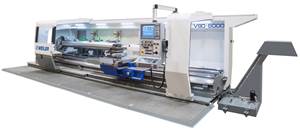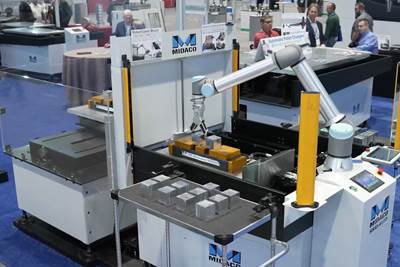Thyssenkrupp Bilstein has run out of presidents. At the company’s manufacturing site in Hamilton, Ohio, automation projects make use of collaborative robots, or cobots, that the team identifies by naming them after presidents of the United States. The first cobot installed here was Washington. The first automation attempt failed (more on that below), and while subsequent attempts succeeded, the early wins came slowly. Just getting to the application of the eighth cobot, Van Buren, took years. But now, cobot successes are coming faster. The cobot wins the company expects to realize brings the anticipated cobot list all the way to Biden. “Maybe we’ll need to go to first ladies next,” a team member commented to me.
That level of advance of cobot automation could not have been foreseen in 2016, when the first cobot automation attempt was made. But in 2018, company leaders saw that the difficulty the plant was facing in filling manufacturing positions meant that it would either need to rely more on automation, or manufacture elsewhere. Other manufacturers like it were shifting production operations outside the United States. Bilstein wanted to keep producing in Ohio, and in two smaller facilities in California and North Carolina. Therefore, the way forward was to commit to automation and find the way to succeed.
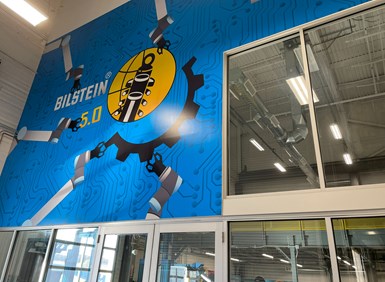
The group responsible for advancing automation at Bilstein is called Industry 5.0. By design, this group is a separate team. It has its own space in the plant, and its members are not borrowed from or beholden to day-to-day production.
The company makes high-performance shock absorbers. Its customers are major automakers. Thus, Bilstein is not a machined part provider; its automation applications largely relate to assembly. However, the company does face an extreme version of a problem almost any manufacturer might recognize. According to COO and Director of Operations Brian Williams, the Hamilton plant’s current staffing (in the hundreds of employees) should be much higher than it is, because 10 percent of Bilstein’s manufacturing positions company-wide are currently going unfilled. And while automation at this facility includes much more than cobots (including conventional robots as well as autonomous guided vehicles), the advance of automation here demonstrates how often cobots figure into the kind of manufacturing Bilstein calls “Industry 5.0,” meaning automation that seamlessly integrates with the work of people. Collaborative robots are inexpensive, redeployable and safe to use alongside workers, making them the go-to choice for most automation opportunities the plant finds.
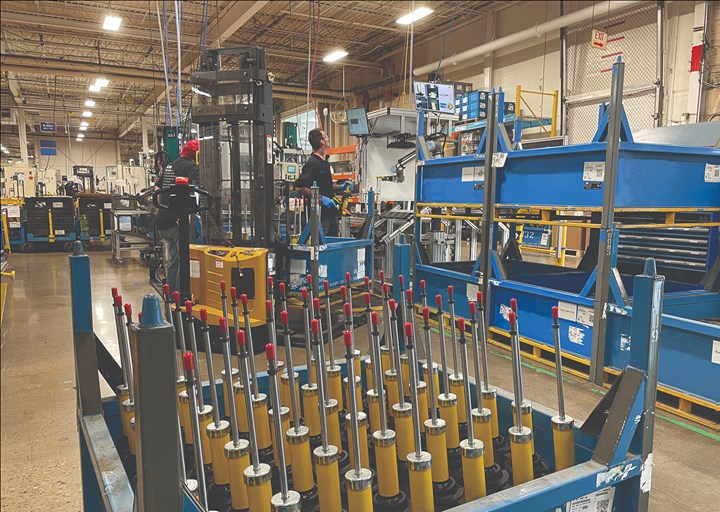
The plant manufactures shock absorbers. Its employees now routinely work near collaborative robots, as seen here in the background. The 33 cobots now in use in this plant come from Universal Robots.
“They take the pressure off employees,” Williams says. One cobot runs three shifts, so it essentially aids the work of three different employees. In this way, he notes, “Letting a cobot perform a task that lends itself to automation lets us redirect various employees to something more difficult.” Continuing to pursue opportunities to do this is how the plant is able to meet its production demands despite its unfilled positions.
In just a handful of years, how did Bilstein go from faltering with automation to having so many cobots in operation that one is running near or in view of most production employees? In learning about Bilstein’s journey from company team members during a recent visit (too many to list here; see names at the end of the article), I found various tactics nearly any manufacturer might adopt in order to realize a more automated facility. Two of these tactics are operational, and two involve important investments:
1. Create an automation team
Bilstein’s first cobot application failed because the company relied too heavily on an outside integrator, the company says. The solution succeeded initially, but could not keep succeeding because it was created without appreciation for how the plant might need to adapt it or take it farther. The lesson was clear: “We needed to develop internal expertise,” says Williams.
What’s more, that expertise had to operate separately from day-to-day production. “The production staff is KPI-focused,” he says, meaning key performance indicators. This should be their focus. But the automation team needs to be focused on transformation, guided not by today’s performance, but by the need to enable a process to run without human attention. This automation team has its own area in the plant for system development, and it remains dedicated to automation because the opportunities never end. Instead, success causes the opportunities to come faster, making the in-house expertise increasingly more valuable.
2. Advance by easy wins
One automation team member expressed the plant’s best advice this way: “Do not go for the shiny application of automation. Go for the easiest win!” For Bilstein, this method of prioritizing automation efforts has probably done the most to enable the spread of cobots through the facility. An impressive application automating a complex operation might remain distant from the staff even if it succeeds. But realizing many quick wins enables employees to see automation succeeding in various ways.
Bilstein even has a system for translating its successes into subsequent easy wins. For every successful application, a next step is to look for other automation possibilities that are so similar to that success that the lessons of this application can simply be replicated (“Copy and paste,” the team says) to realize the new possibility.
3. Expand 3D printing capability

The three cobots in this automated cell for rod and valve assembly are named after presidents Coolidge, Hoover and FDR. A companion article features video that shows the 3D printed hardware in this cell that aids unattended production.
Cobots and 3D printing go together. At Bilstein, seemingly every successful cobot application has also involved custom hardware elements enabling the cobot to move without interference and to grip and place parts precisely. 3D printing is the resource enabling Bilstein engineering team members to iterate and produce these custom hardware elements quickly. Its in-house additive manufacturing resources have grown to 14 3D printers.
[Related: The application of AM to cobot automation merits an article in itself. Read a companion article from Additive Manufacturing detailing 3D printing parts used in cobot cells at Thyssenkrupp Bilstein.]
4. Invest in winning the culture
“Five years ago, no one mentioned cobots, but now we have a culture where everyone is looking for cobot opportunities,” Williams says. Part of this is because of point 2, the tactic for prioritization that lets automation spread. But more than that, the Bilstein automation team also takes care to involve employees who will be affected by an automation project in the development of that project from the outset.
A holographic viewer is an aid not just to engineering but to advancing the culture as well. Employees potentially affected by new automation applications can (literally) see what is coming and give meaningful feedback well in advance. Seen here: Bilstein Mechanical Engineer Herman Baker.
One investment the company made is as much a cultural resource as an engineering aid. A Microsoft HoloLens 2 holographic viewer allows automation team members to evaluate potential systems in augmented reality before any physical hardware is created or installed. It also allows potential users of that system to visualize, and provide feedback on, the system that they will be getting. Employees become part of the plant’s future by being invited to see it and shape it before it comes.
Indeed, employee participation and buy-in has been vital to finding the way to thrive with fewer employees, notes Williams. “The recipe is product, process, people,” he says. “If you run too far with just the first and second of those, you create problems that are hard to fix later.”
Thank you to Thyssenkrupp Bilstein team members I spoke to for this article, including Herman Baker, Drew Guthridge, Sarah King, Craig Mathews, Nick Rumberger, Fabian Schmahl and Eric Sorosiak.
How Additive Manufacturing and Collaborative Robots Go Together
A companion article and video on Additive Manufacturing Media describe how Bilstein has found 3D printed components and internal 3D printing capacity to be vital for equipping cobot cells.
Related Content
CNC Machine Shop Honored for Automation, Machine Monitoring
From cobots to machine monitoring, this Top Shop honoree shows that machining technology is about more than the machine tool.
Read MorePartial Automation Inspires Full Cobot Overhaul
Targeting two-to-four hours of nightly automation enables high-mix manufacturer Wagner Machine to radically boost its productivity past a single shift.
Read MoreWeiler to Debut New Automation Features For Its Lathes
Weiler’s V 110 four-way precision lathe introduces features new to the U.S.
Read MoreView From My Shop Video 1: A Deep Dive Into Automation with Advance CNC
Advance CNC leverages multiple forms of automation to increase its milling machines' productivity. Learn more in this episode of The View From My Shop.
Read MoreRead Next
Better Together: Combining Cobots and Palletization
Using a collaborative robot to tend a machine with a pallet changer can help shops maximize unattended machining time.
Read MorePartial Automation Inspires Full Cobot Overhaul
Targeting two-to-four hours of nightly automation enables high-mix manufacturer Wagner Machine to radically boost its productivity past a single shift.
Read More

.jpg;width=70;height=70;mode=crop)
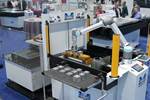
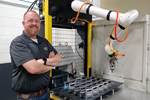




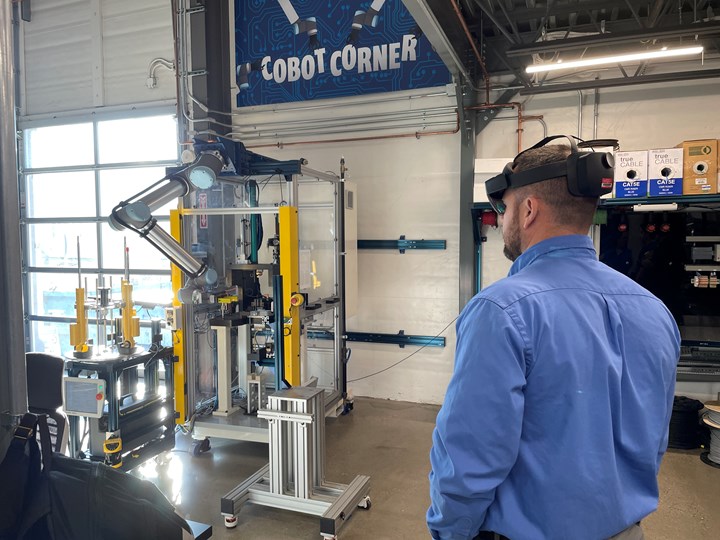
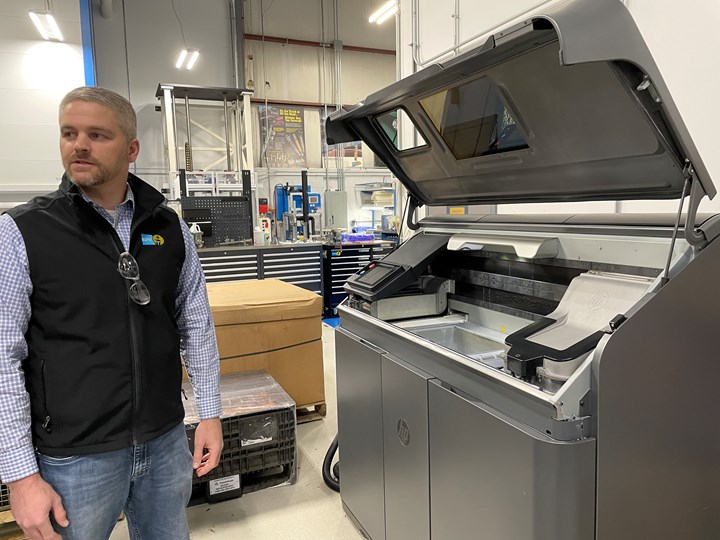







.png;maxWidth=300;quality=90)
.png;maxWidth=300;quality=90)









